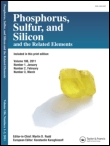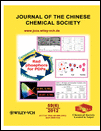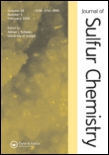
PHOSPHORUS SULFUR AND SILICON AND THE RELATED ELEMENTS
Scope & Guideline
Fostering Insights into Phosphorus, Sulfur, and Silicon Chemistry
Introduction
Aims and Scopes
- Synthesis and Characterization of Compounds:
The journal emphasizes the development of new synthetic methodologies for phosphorus, sulfur, and silicon compounds, with a focus on novel reaction pathways and innovative techniques. - Applications in Biological and Medicinal Chemistry:
Research often explores the biological activities of synthesized compounds, including their antimicrobial, anticancer, and pharmacokinetic properties, highlighting their potential therapeutic applications. - Materials Science and Nanotechnology:
The journal features studies on the application of phosphorus, sulfur, and silicon compounds in materials science, including nanomaterials, catalysts, and advanced materials for electronics and optoelectronics. - Environmental Chemistry and Remediation:
Papers often address environmental applications, such as the removal of pollutants, waste management, and the remediation of contaminated sites using phosphorus and sulfur-based compounds. - Theoretical Studies and Computational Chemistry:
The journal includes theoretical and computational studies that provide insights into reaction mechanisms, molecular properties, and the design of new compounds.
Trending and Emerging
- Nanotechnology and Nanomaterials:
There is a growing emphasis on the synthesis and application of nanostructured materials, particularly those incorporating phosphorus, sulfur, and silicon, for use in catalysis, electronics, and drug delivery systems. - Green Chemistry and Sustainable Practices:
Research highlighting environmentally friendly synthesis methods and sustainable practices has surged, aligning with global initiatives to reduce chemical waste and promote green chemistry. - Computational and Theoretical Chemistry:
An increasing number of papers employ computational methods to predict molecular behavior and optimize synthesis routes, reflecting a trend towards integrating theoretical frameworks with experimental research. - Biological Activity and Drug Development:
There is a marked increase in studies focusing on the biological evaluation of new compounds, particularly in the context of drug discovery and the development of novel therapeutic agents. - Functional Materials for Energy Applications:
Emerging themes include the development of phosphorus, sulfur, and silicon-based materials for energy applications, such as batteries, solar cells, and fuel cells, demonstrating the journal's relevance to current energy challenges.
Declining or Waning
- Traditional Organophosphorus Chemistry:
There has been a noticeable decrease in papers focusing on classical organophosphorus compounds and their applications, possibly due to the increasing interest in more complex and multifunctional materials. - Synthesis of Simple Sulfur Compounds:
The frequency of studies involving the synthesis of basic sulfur compounds has waned, as researchers are now more inclined to explore complex organosulfur compounds with advanced functionalities. - Phosphorus Fertilizers and Agricultural Applications:
Research related to conventional phosphorus fertilizers and their agricultural applications has diminished, likely due to a shift towards more sustainable and innovative approaches in agriculture.
Similar Journals

RUSSIAN JOURNAL OF ORGANIC CHEMISTRY
Fostering Knowledge in Organic Chemistry DynamicsRUSSIAN JOURNAL OF ORGANIC CHEMISTRY, published by MAIK NAUKA/INTERPERIODICA/SPRINGER, stands as a pivotal resource in the realm of organic chemistry, catering to an audience of researchers, professionals, and students keen on the latest advancements in this dynamic field. With an ISSN of 1070-4280 and E-ISSN of 1608-3393, this journal has been a fixture in academic literature since its inception in 1996 and continues to play a significant role as it converges towards 2024. Despite currently holding a Q4 ranking in organic chemistry and a modest placement in the Scopus ranks, the journal offers valuable insights and contributions that reflect the ongoing research and trends within the discipline. Though it does not operate under an open access model, the journal provides essential studies and reviews that enhance scientific dialogue and innovation. Located in the United States, the journal supports the advancement of organic chemistry, fostering a deeper understanding of complex chemical interactions and methodologies.

BIOINORGANIC CHEMISTRY AND APPLICATIONS
Innovating solutions through interdisciplinary research.BIOINORGANIC CHEMISTRY AND APPLICATIONS, published by HINDAWI LTD, is a distinguished journal dedicated to advancing the field of bioinorganic chemistry, offering an open access platform since 2008. With an ISSN of 1565-3633 and E-ISSN of 1687-479X, this journal provides a global forum for researchers, practitioners, and scholars in the vibrant fields of Biochemistry, Inorganic Chemistry, and Organic Chemistry. Recognized for its scholarly impact, it holds an impressive Q2 rank in Biochemistry and Q1 ranks in both Inorganic and Organic Chemistry in the 2023 metrics. Catering to a diverse audience, the journal emphasizes the importance of interdisciplinary research and the application of inorganic chemistry in biological systems. With an accessible range of articles aimed at fostering scientific dialogue and innovation, BIOINORGANIC CHEMISTRY AND APPLICATIONS plays a crucial role in shaping future research and application in the chemical sciences.

JOURNAL OF THE CHILEAN CHEMICAL SOCIETY
Fostering Excellence in Chemistry Research.The Journal of the Chilean Chemical Society, published by the Sociedad Chilena de Química, serves as a premier platform for disseminating significant research findings in the field of Chemistry. With an ISSN of 0717-9707, this journal has established its presence since 2003, providing open access to a diverse range of studies and advancements in this vital scientific domain. It currently holds a Q3 category ranking in Chemistry (miscellaneous) and ranks 196 out of 408 in the general chemistry category on Scopus, indicating its valuable contributions to the field. Through the journal, researchers, professionals, and students are encouraged to engage with cutting-edge research and foster collaboration among the scientific community in Chile and beyond. The society's commitment to excellence ensures that articles published reflect high-quality research, underpinning the journal’s role in shaping knowledge and innovation in chemistry.

JOURNAL OF THE CHINESE CHEMICAL SOCIETY
Illuminating the Path of Chemical InnovationJOURNAL OF THE CHINESE CHEMICAL SOCIETY, published by WILEY-V C H VERLAG GMBH, is a vital resource in the field of chemistry, focusing on a broad array of topics pertinent to general chemistry and its advancing sub-disciplines. Established in 1954 and running through 2024, this journal serves as a significant platform for the dissemination of high-quality research, showcasing innovative findings and developments within the chemical sciences. With its Q3 category ranking and positioning at Rank #203 in General Chemistry per Scopus, it reflects the journal's commitment to research excellence and impact. While not an open-access publication, it ensures accessibility to a global audience, making it an essential tool for researchers, professionals, and students alike seeking to stay informed and engaged in the evolving landscape of chemistry.

CCS Chemistry
Transforming Ideas into Impactful Chemistry ResearchCCS Chemistry, published by the esteemed Chinese Chemical Society, is a leading open-access journal dedicated to advancing the field of chemistry. Since its inception in 2019, the journal has rapidly gained recognition, achieving a remarkable impact factor that places it in the prestigious Q1 category in Chemistry (Miscellaneous) as of 2023. With a Scopus ranking of #41 out of 408 in General Chemistry, CCS Chemistry represents the top 10th percentile in its category, reflecting its commitment to high-quality research and innovation. The journal serves as a vital platform for researchers and professionals to share their findings, showcase cutting-edge methodologies, and engage with the latest developments in various chemistry subfields. Accessible to a global audience, CCS Chemistry ensures that groundbreaking research is available without barriers, making it an indispensable resource for students and academics aiming to stay at the forefront of chemical sciences. For further details, submissions, and access to published articles, please visit the journal's website.

Journal of Sulfur Chemistry
Illuminating the World of Sulfur ChemistryThe Journal of Sulfur Chemistry, published by Taylor & Francis Ltd, is a pivotal resource dedicated to the field of sulfur chemistry, offering a unique platform for researchers, professionals, and students alike to explore innovative discoveries and advancements. With an ISSN of 1741-5993 and an E-ISSN of 1741-6000, this journal has been a prominent contributor to the academic discourse since its inception in 2004, converging knowledge and research through the year 2024. Recognized in the 2023 Scopus rankings, it holds a strong position at Q3 in the category of miscellaneous chemistry, ranking #173 out of 408, within the 57th percentile, underscoring its role as a valuable asset in the chemistry community. Although the journal does not currently offer open access, it remains a vital source for novel insights and scholarly articles, significantly impacting ongoing research and education in sulfur chemistry.

Chemija
Cultivating a Deeper Understanding of Chemical Science.Chemija is a prominent journal in the field of chemistry, published by LIETUVOS MOKSLU AKAD LEIDYKLA in Lithuania. With a focus on diverse topics within the realm of chemistry, this journal aims to disseminate original research articles, reviews, and discussions that advance the understanding and application of chemical science. Although it currently holds a Q4 ranking in the miscellaneous category of chemistry, Chemija is committed to elevating its impact through the publication of high-quality research, making significant contributions to the discipline. The journal operates under a non-open access model, ensuring that articles undergo rigorous peer review to uphold academic standards. Researchers, professionals, and students are encouraged to explore the wealth of knowledge within its pages as it endeavors to bridge gaps across various subfields of chemistry from 2008 to 2024. With a dedicated readership and a growing database of insightful publications, Chemija serves as an essential resource in the ever-evolving landscape of chemical research.

Chemical Methodologies
Empowering Researchers with Open Access to ChemistryWelcome to Chemical Methodologies, a premier journal published by SAMI PUBLISHING CO-SPC, dedicated to advancing the field of chemistry through innovative research and methodologies. With an ISSN of 2645-7776 and an E-ISSN of 2588-4344, this journal provides a vital platform for researchers and scholars to share their findings in areas encompassing physical, theoretical, and organic chemistry. Despite its initial HIndex and quartile rankings still being established, the journal's evolving impact within the academic landscape is underscored by its Scopus Ranks, which place it in the 35th percentile for physical and theoretical chemistry and the 33rd percentile for organic chemistry. Since its inception in 2022, and continuing through 2024, Chemical Methodologies aims to foster collaboration and knowledge dissemination among academics and practitioners alike, bridging theoretical concepts and practical applications. This open-access platform enhances accessibility for researchers and students worldwide, ensuring that groundbreaking contributions to chemical science reach a broad audience.

Heterocyclic Letters
Exploring the Frontiers of Heterocyclic ChemistryHeterocyclic Letters is an esteemed journal in the field of synthetic organic chemistry, published by RAMAN PUBL. With ISSN 2231-3087 and E-ISSN 2230-9632, this journal aims to disseminate original research and innovative findings related to heterocyclic compounds, which play a crucial role in medicinal chemistry, material science, and agricultural chemistry. Heterocyclic Letters provides a platform for researchers, professionals, and students to share their insights and advancements, thus fostering academic collaboration and knowledge transfer. The journal is dedicated to maintaining high-quality standards in research publication, making it an essential resource for anyone focused on the latest developments in heterocyclic chemistry. Although it does not currently offer Open Access options, the journal’s rigorous peer-review process ensures that only the most credible and impactful studies are published, contributing significantly to the advancement of the field.

JOURNAL OF THE INDIAN CHEMICAL SOCIETY
Exploring the Frontiers of Chemistry with a Rich HeritageJournal of the Indian Chemical Society, published by Elsevier, stands as a cornerstone in the field of chemistry, particularly representing the rich chemical research emanating from India.
With a significant history dating back to its establishment, this journal encompasses diverse disciplines including Drug Discovery, Electrochemistry, Inorganic Chemistry, Organic Chemistry, and Physical and Theoretical Chemistry, reflecting the evolving landscape of chemical sciences.
Despite being positioned in the Q3 category across multiple quarters, the journal demonstrates promising rankings in various chemistries, highlighting its commitment to advancing the knowledge and application of chemical sciences. While currently not available as an open access journal, the Journal of the Indian Chemical Society is dedicated to providing a platform for high-quality research that fosters innovation and collaboration among researchers, professionals, and students worldwide.
With its continuous publication from 1973 to the present, it serves as an essential repository for cutting-edge findings and developments in chemistry, striving to connect academia with industry and practice.